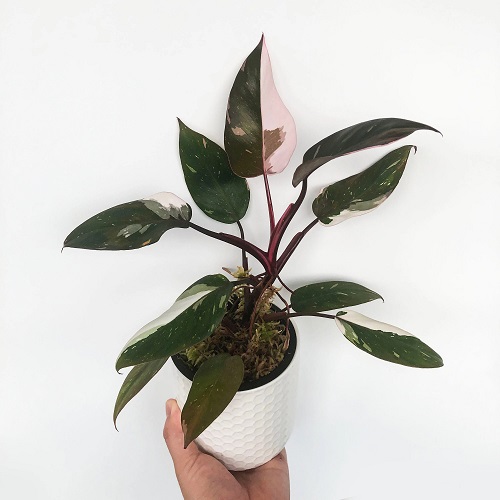Treasured for the variegated glossy foliage, Red Anderson Philodendron will leave an elite impression on your guests!

Ditch the traditional green houseplants and add a splash of colors to your collection with the spectacular Red Anderson Philodendron! Not just the charming foliage, its low maintenance needs will make you fall for this beauty. Here’s a quick guide on How to Grow Red Anderson Philodendron Indoors!
- Botanical Name: Philodendron variegata ‘Anderson’s Red’
- Popular as—Anderson Red Philodendron, Philodendron Anderson Red
- A cross between Philodendron ‘Pink Princess × White Knight’
- Sports glossy foliage splashed in pink that takes a whiter side on maturity
- A slow-growing climber
- Loves bright, indirect sunlight
Red Anderson Philodendron Plant Profile

A cross between Philodendron Pink Princess × White Knight, this hybrid inherits the best of both parents—the foliage emerges with splashes of light pink that harden to the gracious white color with maturity.
The transition of the foliage color from bright red to dark green, complimenting the red stems, is definitely a visual treat. However, the slow-growing tendency of Red Anderson Philodendron gives you ample time to cherish the beauty in all its shades.
This cold-hardy aroid reaches a height of 1-2 feet and loves to climb over nearby objects, so supporting the plant with a moss pole will keep it happy and thriving.
Philodendron Red Anderson vs. Pink Princess
Here are some key pointers to consider when comparing these two varieties:
- Leaf Color: Red Anderson has deep burgundy-red leaves with a glossy sheen, while Pink Princess has variegated leaves that combine dark green, light green, and various shades of pink.
- Variegation: Pink Princess is known for its striking variegation, a sought-after trait among plant collectors, whereas Red Anderson does not exhibit variegation and has uniformly colored leaves.
- Availability and Cost: Pink Princess is rarer and typically more expensive than Red Anderson due to its unique variegation and high demand among collectors.
Ideal Pot Size
Being an aroid, Philodendron Red Anderson will be more than happy to thrive in a 4-6 inches pot with ample drainage holes at the bottom. Depending on the growth of your Red Anderson, choose a one-size bigger container when you see the roots coming out of the drainage holes.
Pair the beautiful Philo hybrid with a glazed ceramic or a neutral-toned pot to complement its beauty.
Red Anderson Philodendron Propagation

This indoor beauty can be easily propagated via cuttings. Get a healthy, disease-free plant and use a sharp, sterile knife or garden clippers to snip a 4-6 inches stem just below the leaf node.
Prepare a pot with orchid mix and perlite and plant the cutting into it. Wet the medium and keep the pot at a spot that receives bright indirect sunlight. Keep the medium moist until you notice new growth—ideally 2-3 weeks. To cut down on the hassle of transplanting a vulnerable new plant, propagate the cutting in a pot where you plan to grow it.
Red Anderson Philodendron Care

Soil
Anderson Red Philodendron has very basic soil requirements, but nothing can be more fatal than using regular garden soil to grow this beauty. Get a fertile aroid substrate combining orchid bark, peat moss, shredded bark, and perlite or vermiculite to aid drainage. A typical orchid-growing medium also goes well for this houseplant.
Light
Find a bright location if you want your Anderson Red Philodendron to unfurl its true colors. A corner that provides bright, indirect sunlight is the best choice for Philodendrons, and our Red Anderson is no different.
If you observe too many leaves getting yellow, including young ones, shift the plant location to a shady spot, as it usually happens due to intense sunlight.
Water
Keep the medium moist but not soggy to enjoy the plant’s best colors. Keep an eye on the top one inch of the medium and water whenever it feels dry to the touch. Ensure, the water seeps out of the drainage holes completely and doesn’t stand near the roots, helping them rot.
Temperature and Humidity
This plant will grow well under normal household temperatures between 70 to 80 F or 21 to 26 C. The plant is relatively cold hardy; however, if the degrees fall below 50 F or 10 C, you might need to give the plant some warmth with room heaters or a mini indoor greenhouse.
Red Anderson Philodendron Care

Here are some major troubleshooting tips for taking care of a Philodendron Red Anderson:
- Yellowing Leaves: This may indicate overwatering or a lack of nutrients. Assess the soil moisture and adjust your watering schedule accordingly. Additionally, make sure to fertilize the plant every 4-6 weeks during the growing season with a balanced, water-soluble fertilizer diluted to half strength.
- Leggy Growth: A sign of insufficient light. Move the plant to a brighter location, ensuring it receives bright, indirect light. Avoid direct sunlight, as it can cause leaf burn. Regularly rotate the plant to ensure even light exposure for balanced growth.
- Root Rot: A consequence of overwatering or poor drainage. Always use a well-draining potting mix and a pot with drainage holes. If you notice a foul smell or mushy roots, remove the affected roots, let the plant dry out, and repot it in fresh soil.
- Loss of Red Foliage Color: Insufficient light may cause the red hue to fade. Increase the amount of indirect light the plant receives to maintain its vibrant red color. Avoid direct sunlight to prevent leaf scorching.
- Droopy Leaves: A result of temperature fluctuations or cold drafts. Maintain a consistent temperature range of 65-80°F (18-27°C) and protect the plant from drafts and sudden temperature changes to keep the foliage healthy and vibrant.
Where to Buy Red Anderson Philodendron
You can find this beautiful plant at various locations, such as local plant shops, specialized nurseries, and online stores. To shop online, search for reputable sellers who focus on providing high-quality houseplants. Well-known online plant retailers include Etsy, Amazon, and Facebook Marketplace, where you may come across Philodendron Red Anderson for Sale.
Before purchasing, always read customer reviews and examine the seller’s reputation to ensure that you receive a healthy and thriving plant. Moreover, consider participating in plant swaps or joining online plant communities. These platforms are excellent for discovering rare or sought-after plants and connecting with fellow plant enthusiasts.






